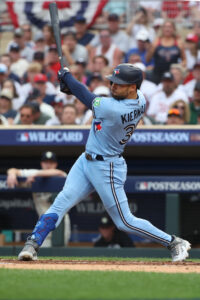The Red Sox are taking on a flier on Lucas Giolito. The sides are reportedly in agreement on a two-year, $38.5MM guarantee that allows the CAA client to opt out after the first season. Giolito will collect an $18MM salary...
The Red Sox are taking on a flier on Lucas Giolito. The sides are reportedly in agreement on a two-year, $38.5MM guarantee that allows the CAA client to opt out after the first season. Giolito will collect an $18MM salary next year and would receive a $1MM buyout if he exercises the opt-out. His ’25 salary is worth $19MM.
If he doesn’t opt out next winter, a conditional option kicks in covering the 2026 campaign. Were Giolito to throw fewer than 140 innings in 2025, the Sox would have a $14MM club option. If he reaches or tops 140 frames, he’d convert that provision to a $19MM mutual option. Regardless of the option value, there’d be a $1.5MM buyout. The deal also contains $1MM in performance bonuses in each of the next two seasons.
It’s a modified pillow contract for the 29-year-old. That reflects a dismal final few months of last season. Giolito looked on track for a nine-figure deal early in the summer. Over his first 21 starts with the White Sox, he carried a 3.79 ERA while striking out more than a quarter of batters faced. Chicago’s fall out of contention made him one of the top starters available at the deadline.
A trade sending Giolito alongside reliever Reynaldo López to the Angels looked like a boost to his market value. Joining a fringe contender gave him an outside shot at a playoff berth. More meaningfully for his free agency, it took the qualifying offer off the table, as players who change teams midseason can’t be issued the QO.

That’s not how things played out. Giolito was one of the worst pitchers in MLB from the deadline onwards. He made only six starts for the Halos before they placed him on waivers, dumping the remainder of his salary after the team fell from contention to help limbo underneath the luxury tax line. Giolito was hit hard for both Los Angeles and the Guardians, who snagged him off the waiver wire at the end of August.
Over his final 12 appearances, he was tagged for a 6.96 ERA through 63 1/3 innings. He was staggeringly prone to the longball, allowing 21 homers (nearly one in every three innings) over that stretch. His walk rate also spiked. He handed out free passes to nearly 11% of opponents after issuing walks at a manageable 8.3% clip in Chicago.
Short of a major injury, it’d be hard to draw up a more frustrating final two months before free agency. That said, there’s a lot in his career résumé that made him arguably the top reclamation target in the rotation class. Giolito turned in upper mid-rotation results between 2019-21, combining for a 3.47 ERA with an excellent 30.7% strikeout percentage despite the hitter-friendly nature of Chicago’s Guaranteed Rate Field.
He has allowed nearly five earned runs per nine in each of the past two seasons, albeit for different reasons. His 4.90 mark in 2022 was attributable largely to a .340 average on balls in play, by far the highest rate of his career. That dropped to .274 last season, and his early-season results again painted the picture of a solid #3 starter. Then came the late-season homer barrage that left him with a 4.88 ERA at year’s end.
The longball has always been a bit of a problem for Giolito, but his second-half home run rate is unsustainably high. Boston is betting on positive regression in that department, hoping that’ll result in mid-rotation results. While Giolito’s whiffs are down from his 2019-21 peak, he still misses bats at an above-average level. Opposing hitters have swung through 12.2% of his offerings in each of the last two years, which tops the 10.8% league mark for starting pitchers. His fastball sits around 93 MPH and he misses a decent number of bats with both his changeup and slider.
Giolito’s performance has varied over the past few seasons. His durability has not. The 6’6? hurler has taken the ball almost every fifth day for the last six years. He hasn’t had an injured list stint longer than two weeks at any point in his MLB career. He hasn’t had any arm-related absences as a big leaguer. Giolito has started 29 or more games in each of the past five full schedules and took the full slate of 12 rotation turns during the shortened season. Only Aaron Nola, Gerrit Cole, José Berríos and Patrick Corbin have started more games over that stretch. He’s eighth in the majors in innings pitched since 2018.
A source of volume innings is a sensible addition to a talented but volatile Boston pitching staff. Chris Sale, Nick Pivetta, Brayan Bello, Tanner Houck, Garrett Whitlock and Kutter Crawford are among the in-house options for the Opening Day rotation. Sale has battled various injuries over the past few seasons. Pivetta, Houck, Whitlock and Crawford have all worked out of the bullpen at times. Aside from Crawford, that group has generally found more success in long relief than out of the rotation. Bello’s rotation spot isn’t in jeopardy, but his production dipped at the end of his first full major league season.
That made adding a starter an offseason priority for chief baseball officer Craig Breslow. The Sox were on the periphery of the Yoshinobu Yamamoto market before he signed with the Dodgers. They’d been tied to Jordan Montgomery as well, although recent reporting suggested they were pivoting towards the second tier. Giolito becomes Breslow’s first significant free agent acquisition as Boston’s front office leader. The Sox could still explore the rotation market — they’ve recently been tied to NPB left-hander Shota Imanaga and old friend James Paxton — but this signing may lead them to turn their main focus to another area of need like second base.
The contract falls in line with MLBTR’s prediction of two years and $44MM from the start of the offseason, when we ranked him this winter’s #17 free agent. The two-year guarantee with an opt-out after the first season has become more commonplace in recent years for priority rebound candidates. It affords the player more security than would a straight one-year pact while allowing him to get back to the market after one season if he bounces back.
Giolito turns 30 in July, so he’d be well-positioned for a lofty multi-year pact next winter if he gets on track. Since he was ineligible for the qualifying offer, the signing doesn’t cost Boston any draft compensation. If he pitches well enough to opt out a year from now, the Red Sox would likely make him the QO, allowing them to recoup a draft choice if he only spends one year in Massachusetts.
The Red Sox’s 2024 payroll projection now sits around $187MM, according to Roster Resource. They’re just shy of $200MM from a luxury tax perspective, keeping them $37MM below next year’s lowest threshold. Boston opened last season with a player payroll in the $181MM range after topping $206MM the prior season. They did not exceed the luxury tax threshold in 2023.
Jeff Passan of ESPN first reported the Red Sox were signing Giolito to a two-year, $38.5MM guarantee with an opt-out; Passan was also first with the salary structure and the 2026 option specifics. Chris Cotillo of MassLive first reported the $1MM in annual incentives and specified that the buyout applied regardless of the option scenario.
Image courtesy of USA Today Sports.















